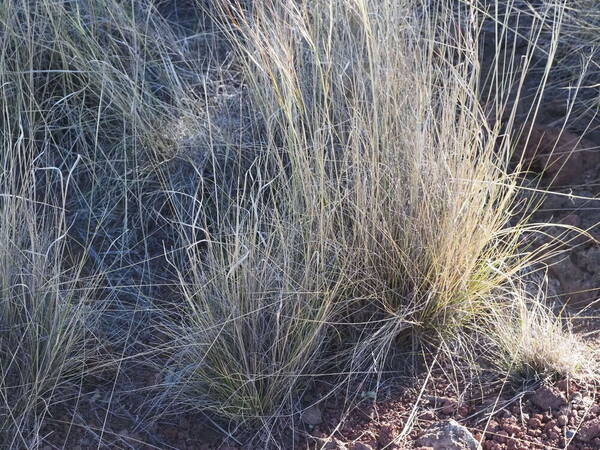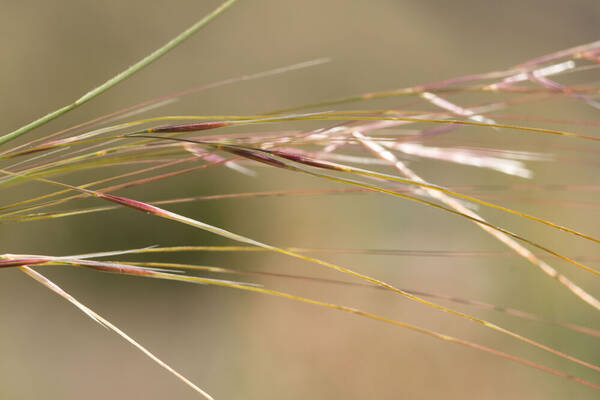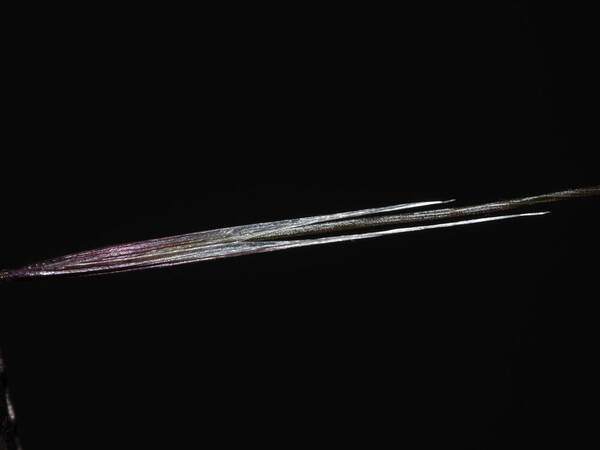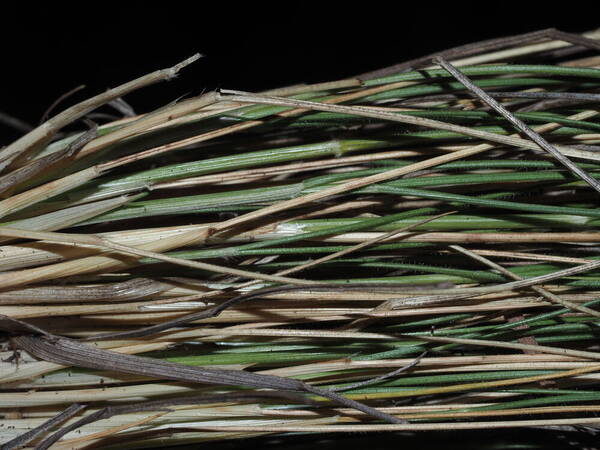Info
Subfamily: Pooideae
Genus etymology: Nassella = "small fishing basket" (with a narrow neck) [Latin] refering to the spikelets
Species etymology: cernua = "nodding" [Latin] refering to the drooping panicle branches
Photosynthetic type: C3 (cool season)
Nativity: naturalized - accidental
First recorded in Hawaiʻi: 1957
Map

Inflorescence






Plant







Habit







Spikelets










Collar


Description
Plants perennial; cespitose, not rhizomatous. Culms 30-100 cm tall, 1-2.2 mm thick, erect or geniculate at the basal nodes, internodes pubescent below the nodes, lowest internodes sometimes pubescent throughout; nodes 2-3, glabrous. Leaves usually glaucous; sheaths mostly glabrous, throats ciliate; collars mostly glabrous, with sparse tufts of hair at the sides, hairs 1-1.6 mm; ligules 0.2-1.6 mm, glabrous, truncate to rounded; blades 3-26 cm long, 0.4-1.2 mm wide, flat to convolute, abaxial surfaces scabridulous, adaxial surfaces hairy. Panicles 15-80 cm, open, often partially enclosed at maturity; branches 1-6 cm, flexuous or cernuous, with 1-8 spikelets on the distal 1/2; pedicels 3-9 mm. Glumes glabrous, narrowly lanceolate, acuminate; lower glumes 12-22 mm long, 0.9-1.7 mm wide; upper glumes 3-4 mm shorter that the lower glumes; florets 4-9 mm long, 0.6-0.8 mm wide, terete; calluses 1.4-3.6 mm, sharp, strigose; lemmas minutely papillose, tapering to the crown, the proximal 1/4 evenly pubescent, the distal 3/4 pubescent only over the veins; crowns 0.2-0.5 mm long, 0.3-0.35 mm wide, straight-sided, rims with 0.8-1.1 mm hairs; awns 50-110 mm long, 0.2-0.3 mm thick at the base, first geniculation evident, second geniculation obscure, terminal segment cernuous; anthers 3.5-5.5 mm, penicillate. Caryopses 4.5-5.5 mm. 2n = 70.
(Description source: Barkworth, M.E., Capels, K.M. & Long, S. (eds.) 1993. Flora of North America, north of Mexico. Volume 24. Magnoliophyta: Commelinidae (in part): Poaceae, Part 1. Oxford University Press, New York. 911 pp. http://floranorthamerica.org/Nassella_cernua )
Perennials; culms erect, forming large, dense clumps, usually 6-9 dm tall. Sheaths glabrous, margins overlapping, membranous; ligule membranous, ca. 2 mm long, margins entire to erose, apex unevenly rounded. Blades glaucous, cauline, 1.2-2.4 mm wide, flat to involute, upper surface evenly pilose, lower surface sparsely pilose or glabrous. Panicles 30-50 cm long or longer, branches numerous, flexuous, ascending or spreading, partially or fully exserted from the subtending sheath; glumes membranous, linear to lanceolate, glabrous, apex acuminate, first glume 12- 19 mm long, 3-nerved, second glume ca. 11 mm long, 3-nerved; lemma chartaceous, 5- 10 mm long, papillose, pilose in lower part and on the nerves, awn 60-110 mm long, twice geniculate, the terminal segment flexuous, scabrous or basally short-pubescent; palea membranous, ovate, 1-1.5 mm long, glabrous, nerveless, apex rounded. Caryopsis pale brown, cylindrical, trigonous, ca. 4 mm long. [2n = 70.]
(Description source: O’Connor, P.J. 1990. Poaceae, pp. 1481–1604. In: Wagner W.L., Herbst D.R. & Sohmer S.H. (eds.)., Manual of the flowering plant of Hawaiʻi. Vol. 2. University of Hawaii Press & Bishop Museum Press, Honolulu )